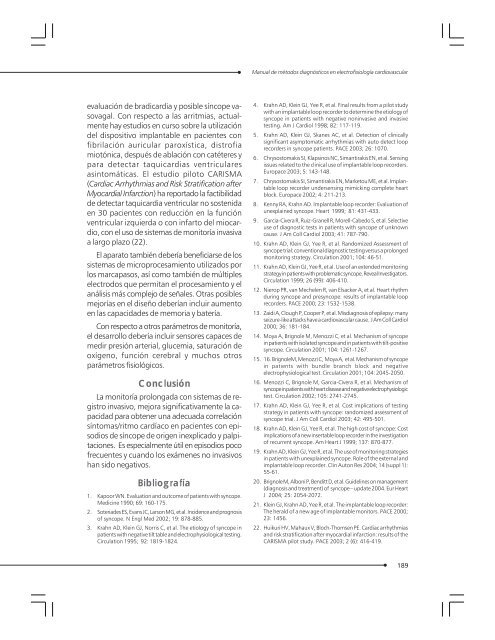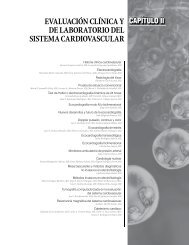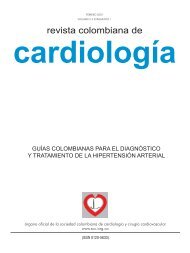Descargar - Scc
Descargar - Scc
Descargar - Scc
Create successful ePaper yourself
Turn your PDF publications into a flip-book with our unique Google optimized e-Paper software.
evaluación de bradicardia y posible síncope vasovagal.<br />
Con respecto a las arritmias, actualmente<br />
hay estudios en curso sobre la utilización<br />
del dispositivo implantable en pacientes con<br />
fibrilación auricular paroxística, distrofia<br />
miotónica, después de ablación con catéteres y<br />
para detectar taquicardias ventriculares<br />
asintomáticas. El estudio piloto CARISMA<br />
(Cardiac Arrhythmias and Risk Stratification after<br />
Myocardial Infarction) ha reportado la factibilidad<br />
de detectar taquicardia ventricular no sostenida<br />
en 30 pacientes con reducción en la función<br />
ventricular izquierda o con infarto del miocardio,<br />
con el uso de sistemas de monitoría invasiva<br />
a largo plazo (22).<br />
El aparato también debería beneficiarse de los<br />
sistemas de microprocesamiento utilizados por<br />
los marcapasos, así como también de múltiples<br />
electrodos que permitan el procesamiento y el<br />
análisis más complejo de señales. Otras posibles<br />
mejorías en el diseño deberían incluir aumento<br />
en las capacidades de memoria y batería.<br />
Con respecto a otros parámetros de monitoría,<br />
el desarrollo debería incluir sensores capaces de<br />
medir presión arterial, glucemia, saturación de<br />
oxígeno, función cerebral y muchos otros<br />
parámetros fisiológicos.<br />
Conclusión<br />
La monitoría prolongada con sistemas de registro<br />
invasivo, mejora significativamente la capacidad<br />
para obtener una adecuada correlación<br />
síntomas/ritmo cardíaco en pacientes con episodios<br />
de síncope de origen inexplicado y palpitaciones.<br />
Es especialmente útil en episodios poco<br />
frecuentes y cuando los exámenes no invasivos<br />
han sido negativos.<br />
Bibliografía<br />
1. Kapoor WN. Evaluation and outcome of patients with syncope.<br />
Medicine 1990; 69: 160-175.<br />
2. Soteriades ES, Evans JC, Larson MG, et al. Incidence and prognosis<br />
of syncope. N Engl Med 2002; 19: 878-885.<br />
3. Krahn AD, Klein GJ, Norris C, et al. The etiology of syncope in<br />
patients with negative tilt table and electrophysiological testing.<br />
Circulation 1995; 92: 1819-1824.<br />
Manual de métodos diagnósticos en electrofisiología cardiovascular<br />
4. Krahn AD, Klein GJ, Yee R, et al. Final results from a pilot study<br />
with an implantable loop recorder to determine the etiology of<br />
syncope in patients with negative noninvasive and invasive<br />
testing. Am J Cardiol 1998; 82: 117-119.<br />
5. Krahn AD, Klein GJ, Skanes AC, et al. Detection of clinically<br />
significant asymptomatic arrhythmias with auto detect loop<br />
recorders in syncope patients. PACE 2003; 26: 1070.<br />
6. Chrysostomakis SI, Klapsinos NC, Simantirakis EN, et al. Sensing<br />
issues related to the clinical use of implantable loop recorders.<br />
Europace 2003; 5: 143-148.<br />
7. Chrysostomakis SI, Simantirakis EN, Marketou ME, et al. Implantable<br />
loop recorder undersensing mimicking complete heart<br />
block. Europace 2002; 4: 211-213.<br />
8. Kenny RA, Krahn AD. Implantable loop recorder: Evaluation of<br />
unexplained syncope. Heart 1999; 81: 431-433.<br />
9. Garcia-Civera R, Ruiz-Granell R, Morell-Cabedo S, et al. Selective<br />
use of diagnostic tests in patients with syncope of unknown<br />
cause. J Am Coll Cardiol 2003; 41: 787-790.<br />
10. Krahn AD, Klein GJ, Yee R, et al. Randomized Assessment of<br />
syncope trial: conventional diagnostic testing versus a prolonged<br />
monitoring strategy. Circulation 2001; 104: 46-51.<br />
11. Krahn AD, Klein GJ, Yee R, et al. Use of an extended monitoring<br />
strategy in patients with problematic syncope. Reveal Investigators.<br />
Circulation 1999; 26 (99): 406-410.<br />
12. Nierop PR, van Mechelen R, van Elsacker A, et al. Heart rhythm<br />
during syncope and presyncope: results of implantable loop<br />
recorders. PACE 2000; 23: 1532-1538.<br />
13. Zaidi A, Clough P, Cooper P, et al. Misdiagnosis of epilepsy: many<br />
seizure-like attacks have a cardiovascular cause. J Am Coll Cardiol<br />
2000; 36: 181-184.<br />
14. Moya A, Brignole M, Menozzi C, et al. Mechanism of syncope<br />
in patients with isolated syncope and in patients with tilt-positive<br />
syncope. Circulation 2001; 104: 1261-1267.<br />
15. 16. BrignoleM, Menozzi C, Moya A, et al. Mechanism of syncope<br />
in patients with bundle branch block and negative<br />
electrophysiological test. Circulation 2001; 104: 2045-2050.<br />
16. Menozzi C, Brignole M, Garcia-Civera R, et al. Mechanism of<br />
syncope in patients with heart disease and negative electrophysiologic<br />
test. Circulation 2002; 105: 2741-2745.<br />
17. Krahn AD, Klein GJ, Yee R, et al. Cost implications of testing<br />
strategy in patients with syncope: randomized assessment of<br />
syncope trial. J Am Coll Cardiol 2003; 42: 495-501.<br />
18. Krahn AD, Klein GJ, Yee R, et al. The high cost of syncope: Cost<br />
implications of a new insertable loop recorder in the investigation<br />
of recurrent syncope. Am Heart J 1999; 137: 870-877.<br />
19. Krahn AD, Klein GJ, Yee R, et al. The use of monitoring strategies<br />
in patients with unexplained syncope. Role of the external and<br />
implantable loop recorder. Clin Auton Res 2004; 14 (suppl 1):<br />
55-61.<br />
20. Brignole M, Alboni P, Benditt D, et al. Guidelines on management<br />
(diagnosis and treatment) of syncope – update 2004. Eur Heart<br />
J 2004; 25: 2054-2072.<br />
21. Klein GJ, Krahn AD, Yee R, et al. The implantable loop recorder:<br />
The herald of a new age of implantable monitors. PACE 2000;<br />
23: 1456.<br />
22. Huikuri HV, Mahaux V, Bloch-Thomsen PE. Cardiac arrhythmias<br />
and risk stratification after myocardial infarction: results of the<br />
CARISMA pilot study. PACE 2003; 2 (6): 416-419.<br />
189




